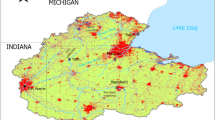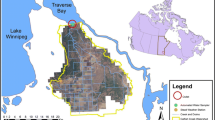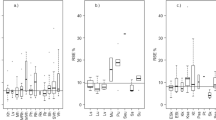Abstract
A mid-lake sample is the conventional sampling strategy used in lake chemistry monitoring programs. Hence, addressing the question of how representative a mid-lake sample is of in-lake conditions is important for interpreting changes in long-term monitoring programs. Our hypotheses were that; (i) the location of a sampling site within a lake will affect its representativity and (ii) a mid-lake sample could be considered representative of average surface water physico-chemistry. We focused on the surface water chemistry in 34 Swedish lakes. To obtain a wide diversity of lake types, the lakes were classified according to mean depth, water residence time, and three main ecoregions. Two sampling seasons were selected, representative of high and low biological activity and stratified and non-stratified conditions, respectively. Ten samples were collected in each lake. The mid-lake samples differed significantly from the nine remaining samples in less than 4% of the total number of two-sample t-tests performed. Samples collected close to lake inlets differed from the other samples more often than samples collected in the central parts of the lakes. We concluded that the location of a sampling site within a lake may affect the sample's representativity of lake water chemistry, and that a mid-lake surface water sample could be considered representative of surface water chemistry.
Similar content being viewed by others
References
Anonymous: 1987, ‘Intern kvalitetskontroll. Handbok för vattenlaboratorier’, Report 3372, Swedish Environmental Protection Agency, Stockholm (in Swedish).
Avois, C., Legendre, P., Masson, S. and Pinel-Alloul, B.: 2000, ‘Is the sampling strategy interfering with the study of spatial variability of zooplankton communities?’, Can. J. Fish. Aquat. Sci. 57, 1940–1956.
Berndtsson, R.: 1987, ‘Application of infiltration equations to a catchment with large spatial variability in infiltration’, Hydrolog. Sci. J. 32, 399–413.
Blomqvist, P.: 2001, ‘A proposed sampling method for composite sampling of water chemistry and plankton in small lakes’, Environ. Ecol. Stat. 8, 121–134.
Dickman, M., Stewart, K. and Servant-Vildary, M.: 1993, ‘Spatial heterogeneity of summer phytoplankton and water chemistry in a large volcanic spring-fed lake in northern Iceland’, Arctic Alpine Res. 25, 228–239.
European Commission: 2000, ‘Directive 2000/60/EC of the European Parliament and of the Council-Establishing a framework for Community action in the field of water policy’, Brussels, Belgium, 23 October 2000.
Falck, J.: 1973, ‘A sampling method for quantitative determination of plant nutrient content of the forest floor’, Royal College of Forestry, Department of Silviculture, Research Notes, No. 1.
Goovaerts, P.: 1998, ‘Geostatical tools for characterizing the spatial variability of microbiological and physico-chemical soil properties’, Biol. Fert. Soils 27, 315–334.
Gustafsson, L. and Ahlén, I. (eds): 1996, Geography of Plants and Animals, Almqvist & Wiksell International, Stockholm.
Illies, J.: 1966, ‘Die Verbreitung der Süßwasserfauna Europas’, in Verhandlungen der Internationale Vereinigung für Theoretische und Angewandte Limnologie, Congress in Poland 1965, Stuttgart, 16, pp. 287–296.
Kratz, T. K., Benson, B. J., Blood, E. R., Cunningham, G. L. and Dahlgren, R. A.: 1991, ‘The influence of landscape position on temporal variability in four North American ecosystems’, Am. Nat. 138, 355–378.
Lacroix, G. and Lescher-Moutoué, F.: 1995, ‘Spatial patterns of planktonic microcrustaceans in a small shallow lake’, Hydrobiologia 300/301, 205–217.
MINITAB release 12: 1997, Minitab Inc., U.S.A.
Nordic Council of Ministers: 1984, ‘Naturgeografisk Regionindelning av Norden’, Nordiska ministerrådet, Oslo, Norway (in Swedish)
Oliver, M. A., Webster, R. and McGrath, S. P.: 1996, ‘Disjunctive kriging for environmental management’, Environmetrics 7, 333–358.
Pinel-Alloul, B.: 1995, ‘Spatial heterogeneity as a multiscale characteristic of zooplankton community’, Hydrobiologia 300/301, 7–42.
Rainwater, F. H. and Thatcher, L. L.: 1960. ‘Methods for Collection and Analysis ofWater Samples’, Geological Survey Water-Supply Paper 1454, U.S. Government Printing Office, Washington.
Visman, V., McQueen, D. J. and Demers, E.: 1994, ‘Zooplankton spatial patterns in two lakes with contrasting fish community structure’, Hydrobiologia 284, 177–191.
Wetzel, R. G.: 1983, Limnology, 2nd ed., CBS College Publishing.
Wetzel, R. G. and Likens, G. E.: 1991, Limnological Analyses, 2nd ed., Springer-Verlag, New York.
Wiederholm, T. and Johnson, R. K.: 1997, ‘Monitoring and Assessment of Lakes and Watercourses in Sweden’, in J. J. Ottens, F. A. M. Claessen, P. G. Stoks, J. G. Timmerman and R. C. Ward (eds), Monitoring Tailor-made II, Information Strategies in Water, Nunspeet, The Netherlands, pp. 317–329.
Wilander, A.: 1997, ‘Referenssjöars vattenkemi under 12 år; tillstånd och trender’, Report 4652, Swedish Environmental Protection Agency, Stockholm (in Swedish).
Wilander, A., Johnson, R. K., Goedkoop, W. and Lundin, L.: 1998, ‘Riksinventering 1995. En synoptisk studie av vattenkemi och bottenfauna i svenska sjöar och vattendrag’, Report 4813, Swedish Environmental Protection Agency, Stockholm (in Swedish) (English summary).
Yasuda, H., Berndtsson, R., Bahri, A., Persson, H., Gullberg, A. and Jinno, K.: 1994, ‘Spatial Correlation Analysis of Two-dimensional Solute Transport in the Unsaturated Zone’, in K. W. Hipel (ed.), Stochastic and Statistical Methods in Hydrology and Environmental Engineering 2, pp. 127–138, Kluwer Academic Publishers, The Netherlands.
Author information
Authors and Affiliations
Corresponding author
Rights and permissions
About this article
Cite this article
Göransson, E., Johnson, R.K. & Wilander, A. Representativity of a Mid-lake Surface Water Chemistry Sample. Environ Monit Assess 95, 221–238 (2004). https://doi.org/10.1023/B:EMAS.0000029905.07072.b0
Issue Date:
DOI: https://doi.org/10.1023/B:EMAS.0000029905.07072.b0




